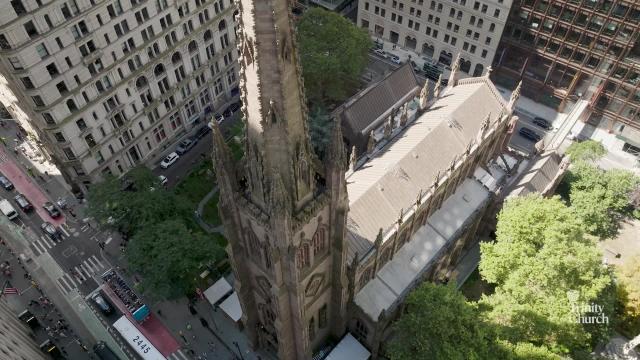War and Remembrance in Trinity Churchyard

On Monday, the nation pauses for Memorial Day, to remember the individuals who died in service of the country’s armed forces. While many veterans are interred in Trinity parish cemeteries, fewer are buried here who died while serving. General Richard Montgomery and Captain James Lawrence are two notable exceptions.
Captain James Lawrence
Lawrence was born in Burlington, New Jersey in 1781 and raised in Woodbury. He was commissioned as a lieutenant in the U.S. Navy in 1802 and saw action in Tripoli during the First Barbary War.
In 1813, after successfully sinking the H.M.S. Peacock, Congress issued a medal in Lawrence’s honor, and he was quickly promoted to captain and put in charge of the frigate U.S.S. Chesapeake, stationed in Boston Harbor. In late May the frigate H.M.S. Shannon sailed into Massachusetts Bay and on June 1, 1813, its captain, Philip Broke, challenged Lawrence to the maritime equivalent of a duel. The frigates would meet at the Boston Light and fight it out, unassisted by other ships. Lawrence agreed, and the ships met in the late afternoon in full view of Bostonians who congregated on rooftops to watch the showdown. For more information about the controversy surrounding this battle, please read this Boston Globe article.
The battle began at 6pm and, despite its gentlemanly beginnings, quickly turned bloody. A total of 228 men were killed in the fourteen-minute battle. Lawrence was hit twice, and after the second wound issued his famous command: “Don’t give up the ship! Fight her til she sinks!” He was taken below deck for surgery as the victorious British boarded the Chesapeake.
Lawrence died three days later of his wounds, leaving behind his pregnant wife, Julia Montaudevert, and a two-year-old daughter. He was briefly survived by his aide, Lieutenant Augustus Ludlow, who succumbed five days later.
Commodore Oliver Hazard Perry, a friend of Lawrence, adopted Lawrence’s famous command as his personal battle cry. He had a large war flag featuring the phrase created and displayed during sea and lake battles throughout the remainder of the war.
Lawrence and Ludlow were first interred in Halifax, Nova Scotia, before their remains were moved to Salem, Massachusetts and later to Trinity churchyard. The church erected the current monument, located in the south churchyard, in 1846. The four-sided monument honors Lawrence, Ludlow, and Lawrence's wife, Julia, who died in 1865. Intact parts of an earlier monument were given to the New York Historical Society.
General Richard Montgomery
Richard Montgomery was born into a family of landed gentry in Ireland in 1738. He studied at Trinity College in Dublin and joined the British army when he was 18. In 1757, during the Seven Years War, his regiment was sent to Canada to help force the French out of North America. Montgomery spent the next eight years in North America, taking part in successful British campaigns in Canada, the French West Indies, Cuba, and against Pontiac’s Rebellion. He was promoted from ensign to captain during that time.
Montgomery returned to England in 1765 and found life in the peacetime army difficult. Lacking a wealthy or influential patron, he was unable to rise through the military ranks. He became increasingly dissatisfied with the British government. In 1772, he sold his commission in the army and migrated to America.
Montgomery purchased an estate and married into a family of prominent New York patriots, planning the quiet life of a gentleman farmer. In 1775, though he did not seek office, Montgomery was elected to New York’s Provincial Congress, and later entered the new Continental Army as a brigadier general. Montgomery would now fight against the British army in which he once served.
George Washington assigned Montgomery the role of deputy commander under Major General Philip Schuyler, future father-in-law of Alexander Hamilton, and ordered their forces to invade Canada. Schuyler soon fell ill, leaving Montgomery in full control of the operation. Montgomery oversaw the successful siege of Fort St. Jean and the capture of Montreal in the fall of 1775. He was promoted to major general as a result of these victories, though he never learned of his promotion.
Montgomery and his troops then marched on Quebec. On December 30, in a heavy snowstorm, Montgomery led an advance force into the city and was killed by grapeshot. He was given an honorable burial by British commanders in Quebec.
On January 25, 1776, Congress approved creation of a memorial for Montgomery—the first monument ever commissioned by the United States. Benjamin Franklin, who would oversee the monument’s construction in France, was advanced 300 pounds sterling to cover the costs (about $45,000 today).
After spending nearly a decade languishing in transit, the memorial was installed in the east window of St. Paul’s Chapel in June of 1788.
In 1818, Montgomery’s widow Janet was able to persuade the New York State legislature to authorize moving Montgomery’s remains from Quebec to a tomb below his monument at St. Paul’s Chapel. It is said that Janet Montgomery watched from along the banks of the Hudson River as the remains of the husband she had not seen in 43 years passed by on a boat to New York City. Montgomery’s remains were re-interred at St. Paul’s Chapel on July 8, 1818, amidst great fanfare.









